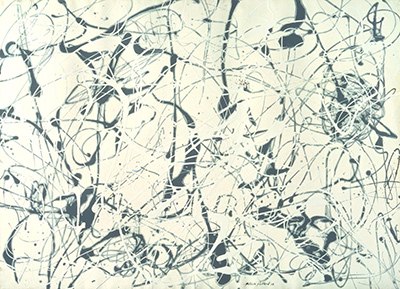Number 23 was executed by Jackson Pollock in 1948. The work was executed in black and white enamel paint which was poured onto a gesso surface applied to paper.
The work is significant in that, executed in the Abstract Expressionist style, it combines what would later be referred to as Pollock's Black Pour work and what was already termed his action or drip technique.
In this piece the control exercised by Pollack over the direction of the paints is very evident. Using simply black and white the artist has created a swirling, interacting fusion of lines that give rise to intricate forms.
The physical gestures and movements made by Pollock as he executed the piece demonstrate sublime control, whilst at the same time suggesting that Pollock moved with rhythm and exercised choice over the flow and direction of his paints.
For any who have levelled the criticism that it is easy to simply pour and throw paint at a canvas to artistic effect, this piece, with its subtle shades of black and white, must constitute one of the strongest rebuffs.
Where the black paint has merged with the white painted background, forming some grey areas, this provides a contrast between the stark whites and blacks of the body of the piece.
The goal of abstract expressionism is to free oneself from the rigours of form and classical execution and Pollock succeeds on an extremely subtle level with Number 23.
It is significant that the piece is devoid of any title that might suggest imagery that detracts from the work speaking purely for itself and to each individual viewer. Pollock adopted the habit of giving his works only numbers in 1948.
Number 23 is on exhibition in the Tate Modern Gallery, London, England, having been purchased by the Friends of the Gallery in 1960.




